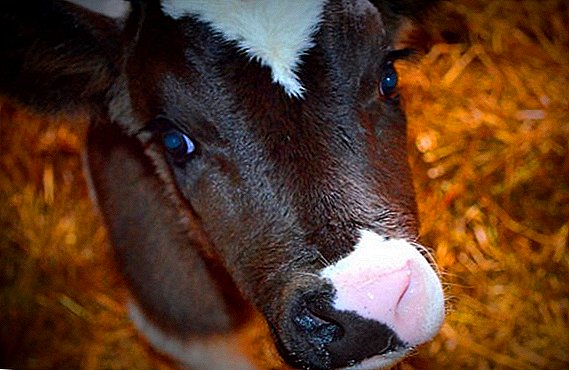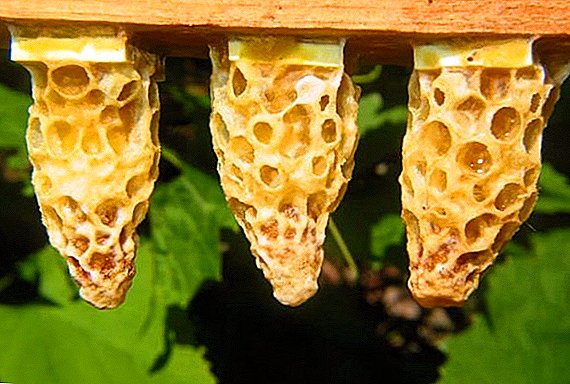 For a number of reasons, the natural division of bee colonies is not always acceptable for a beekeeper.
For a number of reasons, the natural division of bee colonies is not always acceptable for a beekeeper.
It is preferable to fully control this process and, if necessary, arrange artificial swarming.
Let's try to figure out how to do it.
Description
It is possible to form new bee families both from full-fledged families and with the help of so-called. nuclei, i.e. small individual families, formed artificially. To create a nucleus, they remove from a strong family up to two frames with brood and 1-2 feed frames. They are placed in a new hive, which is then transferred to another place.
At the same time, the old bees return to their family, and the young form a new colony, for which they are given a barren uterus or a mature mother liquor is attached.
Important! At first, young bees are not able to provide themselves with water, so for the first five days they need to put a drinking trough.
After the appearance of the new uterus and the onset of worms begin to create a full-fledged bee family. The nucleus is reinforced with ripe brood frames — first add one or two frames, and after a few days two more. In the future, the colony develops independently.  The method of dividing a bee colony in half or in half a summer involves the use of a full-fledged strong family. Such a family is mechanically divided approximately equally, from each half a new colony is formed.
The method of dividing a bee colony in half or in half a summer involves the use of a full-fledged strong family. Such a family is mechanically divided approximately equally, from each half a new colony is formed.
The breeding of bee colonies, called "plaque on the uterus", is practiced when the family is ready for natural swarming, that is, it has laid down swarm mother queen cells.
With this method, the colonies are separated so that flight insects with the uterus remain in one hive, and non-flying and offspring in the other.
Learn a lot of interesting things about such types of honey as black-and-white, hawthorn, esparcetovy, acacia, chestnut, buckwheat, lime, phacelia, coriander, pumpkin, rapeseed, dandelion.
General comparison with natural breeding
The natural separation of families through swarming has significant drawbacks compared with planned artificial separation. In particular, during the swarming process, the collection of honey is significantly (up to 50%) reduced.  In addition, natural swarming is often chaotic - some families swarm, others do not. In such conditions it is practically impossible to plan the growth, development of the apiary.
In addition, natural swarming is often chaotic - some families swarm, others do not. In such conditions it is practically impossible to plan the growth, development of the apiary.
Did you know? Each bee brings relatively little honey in its life, about 1/12 tsp. But the large number of bee colonies allows them to collect impressive volumes of this valuable product during the season. - up to 200 kg. At the same time during the winter they eat an average of 35 kg of honey.Under conditions of natural breeding of bee colonies, the uterus appears uncontrollably, including from weak families that are undesirable for further development. The age and origin of queens in swarms is often impossible to establish.
In such circumstances, the beekeeper is not possible to establish breeding work.
Frequent cases are the loss of swarms that do not take root in the apiary. To avoid such losses, it is necessary to observe the apiary for quite a long time. The collection of scattered swarms can be difficult (for example, if the swarm settled on the top of a tree).  Thus, the natural separation of bee colonies reduces the productivity of the apiary, interferes with breeding work, causes a lot of trouble for the preservation of separated families. All these problems can be avoided by controlling the process.
Thus, the natural separation of bee colonies reduces the productivity of the apiary, interferes with breeding work, causes a lot of trouble for the preservation of separated families. All these problems can be avoided by controlling the process.
On the other hand, natural swarms have certain advantages over artificially formed families. They quickly and efficiently build up honeycombs and work more productively in the medical area.
Did you know? During the day, the bee is able to examine more than 5 thousand flowers. All the bees of the world in just one day pollinate more than a trillion flowers.
Breeding biology
The whole season in the bee family there are processes that affect its population - the emergence of new bees and the death of old ones. By early spring, bees die more than are born, and the number of colonies decreases.  But gradually the decline in numbers comes to naught, and then a rather rapid growth of the colony is observed due to active reproduction.
But gradually the decline in numbers comes to naught, and then a rather rapid growth of the colony is observed due to active reproduction.
At a certain point, the number of eggs laid every day by the uterus reaches a peak. At the same time, an excess of the nurslings appears in the hive, and each larva is served by not one, but up to four such bees.
The emergence of a large number of insects that are not loaded up, as well as the resulting tightness of the family, contribute to the launch of natural swarming.
Formation of bee beads
New bee colonies begin to form with the formation of nuclei (the process was described above). A barren bee uterus is placed in the nucleus and covered with a cap, and the next day the uterus is released from under the cap. After about two weeks, she begins laying eggs. To transform a nucleus into a full-fledged otvodok spend his silting. This process begins immediately after the laying of eggs begins in the young queen. One or two frames of printed brood are placed in the nucleus, and after 5 days another pair of frames is placed there.
Thus, rapid growth of the cutting is achieved, the new bee family becomes self-sufficient and takes an active part in the honey collection.
Instead of barren queens, sealed mature queen cells can also be placed in the nuclei. In this case, the queen cells are gently attached to the top of the honeycomb next to the brood. It is known how long it takes the bee's uterus to get out of the queen cell - 16 days.
But when using a mature queen cell, this process is significantly reduced.  In the future, the layouts are formed in the same way as described above. Formation of cuttings is carried out during the spring before the onset of the main bribe.
In the future, the layouts are formed in the same way as described above. Formation of cuttings is carried out during the spring before the onset of the main bribe.
Individual bee cuts
If the bees for the nucleus and then for the layers are taken exclusively from the same family, then such layers are called individual. This type of layering may excessively weaken the primary family.
Bee collecting
In the case when insects from different families are used to form a new bee colony, the layers are called collective. This method allows you to quickly form large enough layers.
Learn how to make a hive for bees, an alpine hive, a pavilion for bees, a multi-hive hive, a beehive of Dadan.
Dividing a family of bees in half
Use this method of division is possible only in relation to a large strong colony. To do this, to the populated hive, they put an empty one and place half of the framework with brood and fodder frames in it. It does not matter which hive the uterus falls into.  Next, the hives are placed so that both were at a distance of about half a meter, to the right and left of the original location of the populated hive. In this case, the cages should be located in the same way as the cage of the populated hive in its original place.
Next, the hives are placed so that both were at a distance of about half a meter, to the right and left of the original location of the populated hive. In this case, the cages should be located in the same way as the cage of the populated hive in its original place.
Did you know? A bee loaded with nectar cannot be stung.Bees, returning, do not find their hive in the old place and begin to be distributed among two adjacent hives.
If they are distributed unevenly, then the more "popular" hive is pushed away.
Important! For a successful family division, the second hive should roughly correspond to the first one in size, color and appearance.Gradually, beehives are turned around in opposite directions and moved away from each other to permanent places. In the hive, which turned out to be without a uterus, a fetal uterus is placed.

The bee's raid on the uterus or mother queen
For this method, first of all, prepare a new hive, put it in the place of the settled and move there from the old hive two frames with brood, a couple of stern frames and a uterus.
The old hive is transferred to another place of the apiary, and either a new queen or a sealed mother liquor is placed into it.
It should be noted that plaque on the uterus or mother liquor is good for avoiding natural swarming, which may be about to begin. On the other hand, the formed families are initially weakened.
In addition, they have a disproportion: in one colony the flight bees with the uterus, and in the other - non-flying and offspring. 
Simming and Taranov artificial swarming
Other methods are also used to prevent natural swarming. When using the Simmins method, all frames with a worm and honey are moved to the store. These frames are separated from the rest of the empty space at the entrance area by a Hahnemann lattice.
Empty space is filled with a framework with a wrinkle.
You will also be interested to learn about bee venom, the use of beeswax, how to check honey for naturalness, which requires wax refining and honey extractor.Next, two sushi frames are placed on both sides of the entrance. All insects, including the uterus, are shaken off at the bottom of the thus formed nest.
In the future, some of the bees pass through the trellis to the worm, some remain with the uterus and begin to equip a new nest, and the uterus sow the framework. Thus, according to the Simmins method, artificial swarming occurs inside the hive.  The Taranov method involves fumigating the bees with smoke through the entrance and then along the top of the framework. This manipulation causes the bees to collect honey in the zobiki. Before a letkom, a board is installed, one edge of which touches the ground, and the other is located in front of the letk.
The Taranov method involves fumigating the bees with smoke through the entrance and then along the top of the framework. This manipulation causes the bees to collect honey in the zobiki. Before a letkom, a board is installed, one edge of which touches the ground, and the other is located in front of the letk.
The bees, along with the uterus, are shaken to the ground next to the board. Under the board, they stumble into a swarm, which is placed in the swarm. Until the next morning, the roev is kept in a dark cool place. In the morning, all the queen cells in the hive are destroyed, and the swarm is returned to the old place.
Important! If you leave at least one mother liquor, then prevent swarming will not succeed. If you do not destroy the queen cells, but move the swarm to a new hive, but then the primary family will weaken.
Artificial methods of swarming in accordance with Simmens or Taranov have certain disadvantages. Thus, the Simmens method is applicable only to double-hives. In addition, it does not allow to control the quality of the uterus, so it is practiced only in small apiaries.  When swarming in Taranov, it is important to take the bees that have undergone this procedure, work, otherwise swarming will still happen. To the same result will lead and not destroyed in the hive queen.
When swarming in Taranov, it is important to take the bees that have undergone this procedure, work, otherwise swarming will still happen. To the same result will lead and not destroyed in the hive queen.
The use of temporary bee cuttings
In some cases, due to the lack of a productive early bribe, the breeding bees are underloaded with work. As a result, they can begin to dig, which reduces the productivity of the apiary. To solve this problem, temporary bees are used.
They create these layers in such a way that by the beginning of the main bribe, new families could be engaged in honey collection. For this, the layering is formed at the latest 40 days before the main bribe and the fetal uterus is immediately hooked to it.
For the formation of otvodka use the method known as the division of bees in half (see description above). At the same time, a half of the source family and a third can be resettled to a new hive — it all depends on the specific conditions and condition of the colony.  At the end of the season, temporary families are eliminated: bees and brood are attached to the original colony, of the two queens they leave the best one.
At the end of the season, temporary families are eliminated: bees and brood are attached to the original colony, of the two queens they leave the best one.
As a result, the total collection of honey from the main and temporary families is increased compared to the undivided, and a very strong family is going to wintering.
Breeding time
It is important to note that successful breeding of bees with layering is possible only in favorable periods. These terms are calculated based on the calendar of flowering honey plants. The formation of cuttings, as well as artificial swarming spend no later than 5 weeks before the start of the main bribe.
Optimally, the procedure was carried out 50 days before.
In conclusion, the natural swarming of bees, as a rule, is an undesirable phenomenon for beekeepers.  The use of cuttings, as well as methods such as Simmens and Taranov, are effective ways to prevent it.
The use of cuttings, as well as methods such as Simmens and Taranov, are effective ways to prevent it.












